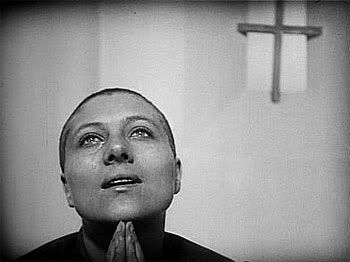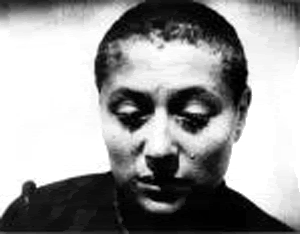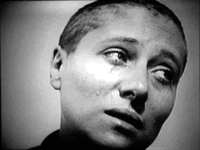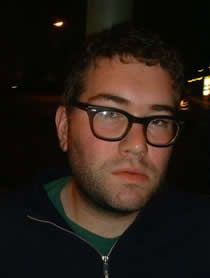Forever Woman
I watched La Passion De Jeanne d'Arc" Thursday night, at Artist's Television Access in the Mission District. (Artists's Television Access is a wonderful resource that I highly reccomend; it's conveniently accessible on Valencia and 21st, and the interior design is visually charged with the same toxic glow that much of the Mission District communicates. The theatre is very small, with a capacity of maybe 25. There were only 12 people in the theatre attending the film.)
The Passion of Joan of Arc (1928) is a silent film, directed by Carl Theodor Dreyer, a Danish filmmaker who only made a handful of films. This was his first feature film, and this original master cut was lost for over fifty years (presumed lost by the director himself) before being discovered in a janitor's closet in a mental institution in Oslo in 1981. (A version of the film is watched by a character in Godard's Vivre sa Vie (1962), but I guess this is the bastardized, edited version.)

The film was originally released as a silent, although the version that was circulated for years included a soundtrack. The version I saw had live accompaniment: an amazing new score by one Lester Raww, an electronic/improvisational guitar guy who's been in bands called Pine Box Boys and The Zag Men.
The core of the film is the actress Maria Falconetti's performance. As the story goes, Dreyer had the script for his meticulously realistic portrayal of the trial and execution of Joan of Arc ready when he spotted Falconetti performing a small play and instantly decided she was "the one" for the roll, because her face communicated an unending depth and heartbreak. "There is a soul behind the face", he said, or something like that. This was her first and only feature film; aparently Dreyer's draining, emotionally intense direction drove her away from the cinema for life. Supposedly, he made her kneel on stone slabs for hours on an end to get the perfect emotional state.

I was interested in watching this film because I read it described as an intense psychological character study focusing on a female face--which it was. All of the shots are intense and claustrophobic, the frame focusing on Joan and her inquisitors from the neck up, the details on their faces rich, textured, and sculpted; the talking heads appearing crepuscular, dense, and chiseled, like emasculate granite slabs showering bible verses at one another, as Raww's soundtrack narrated the intensities of their dialogue and the subtle, slow, powerful leans that their faces made as they lurched from one emotional state to the next. These transitions were some of my favorite parts of the experience and what I felt the new soundtrack did best--it used a post-industrial lexicon to articulate and accentuate emotional "distortion", interpersonal "white noise" and radically violent dark age emotions. It wasn't quite "anachronism" because that term suggests a discconent between supposedly disparate time periods, whereas Raww's post-electronic crackles vibrantly reclaimed the industrial/modernist lense of Dreyer, who himself was (albeit in an attempt to literalize rather than emphasize Joan's story) crunching, decompressing and intensifying a 15th century trial in which no cameras were present. What resulted is more like synchronism, a piece of music being "before its time" and finding its audience too late, an evolutionary trait perfected millenia ago but designed for a plague coming next century, a composition frustratedly designed for an instrument that had yet to be invented. Was it Beethoven who said "I am electrical by nature"? I'm also reminded of the 90's soundtrack to Fritz Lang's Metropolis whose vibrant, acid house intensity made the film as frightening, imposing, and apocalyptic as it was meant to be.
The film, like a much worse 2004 film with a similar name, focuses on Joan's trial, which is assembled from the transcript of actual 15th Century court documents. The clothing was carefully reconstructed, and the sets as well, despite the fact that the painstaking work and funding Dreyer went through were more an act of formal determination, as the film barely has any visible backgrounds or shots that peak below the neckline. The dialogue and the facial expressions take up most of the screentime, and the film lurches operatically between Joan's emotional states. The most frequently visible of these is a vacated, glassy, painful post-heartbreak, one that communicates a strength and love whose Athenic power is still barely enough to hold the architecture of the face in place. Falconetti portrays Joan as a woman who has crumbled emotionally and physically beyond any real human level, but feels such an intense sense of responsibility and knows that she literally can't crumble--she is the child of God; a martyr for France, the most important woman in her country and someone who has been entrusted with a love and a duty beyond understanding. Yet she can't help but break into paroxysms of emotive, personal hurt when she is harassed, taunted, and tortured by her captors--she knows that this is the way it is and why, but her empathy and horror at the turn the revolution has taken is condensed into an interpersonal angst, looks that say "you treat people like this? You treat human beings like this?", let alone, you treat me like this?. What else is there to say about Falconetti's face? The richness of the shots are designed to amplify the nuances of her face, but especially her recognizability: I have met this woman before, I've been looked at in this way before, I've seen the hope drain from a woman's eyes this way before, I have kissed this woman before, but this time I am watching die, being filled with holes, pricked with needles and burning because she believed in something stronger and braver and bigger than I ever did.
The turning point of the film comes after Falconetti has repented and recanted and has been sentenced to life imprisonment; out of seemingly nowhere, what we can only assume is the spirit of god fills her and her eyes light up with a certainty, an absolute understanding that transcends her emotional state. She asks for the inquisitors to return: she lied, everything she said was a lie, and now she wants to tell the truth. Her inquisitors by this point have developed a sympathy for her and assuage her from confessing the best they can, but Joan's decision is final, and she is warmly talked to like a prisoner on death row saying their final prayers. This is where Raww's soundtrack succeeds the most: as Joan comes to her epiphany the music becomes intense, prickly and builds towards a crescendo with hopeful undertones, a moment that stretches out as Joan is lead to her death, and as the pyre is lit, and Joan's face glows, eyes heavenwards, affixed on a dangling crucifix that falls conveniently in her eyesight, the intensities drop out and flatten in infinite plateau; an ambience void of any lost intensities or striations: Joan and Jesus are married in this moment, and as the villagers and rioters tear apart the courthouse and destroy the scenery, as the camera portrays top down visuals of the anarchic, feverish, violent chaos, Joan's sillhoutte burns along with the music and along with her God, consumed, as the viewer should be, by a peace that passes understanding.



